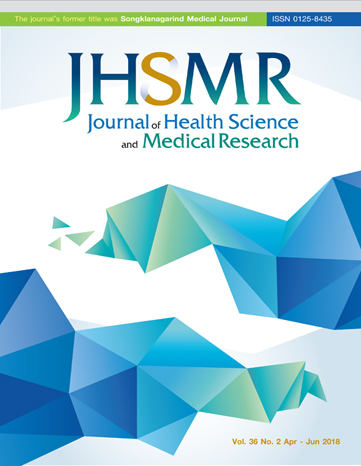Anti-Gastric Ulcer Activity of the Water Extract from Payawanorn (Pseuderanthemum Palatiferum)
DOI:
https://doi.org/10.31584/jhsmr.2018.36.2.1Keywords:
Pseuderanthemum palatiferum, anti-gastric ulcer, pylorus ligation, gastric-wall mucusAbstract
Objective: To examine the anti-gastric ulcer activity of Payawanorn (Psuderanthemum palatiferum) water extract (PPE) in rats.
Material and Methods: Evaluation of anti-gastric ulcer activity of PPE was performed using three induced gastric ulcers models: (1) ethanol/hydrochloric acid (EtOH/HCl), (2) restraint water immersion stress and (3) indomethacin. Ulcer indices were determined by microscopic examination (10X). Pylorus ligation and gastric-wall mucus determination were used to investigate the mechanism of anti-gastric ulcer activity of PPE.
Results: Oral administration of PPE (150, 300 and 600 mg/kg) significantly inhibited gastric ulcer formation induced by EtOH/HCl, by water immersion restraint stress, and by indomethacin in rats (p-value<0.05). PPE at 600 mg/kg showed a high percent inhibition of gastric ulcer formation in all models. In the pylorus-ligated model, pretreatment with PPE had no effect on pH, acidity output or the gastric acid secretion rate, demonstrating that PPE lacks an anti-secretory effect. Gastric wall mucus was markedly preserved by pretreatment PPE at 600 mg/kg (18.91±2.57 μg alcian blue/g wet stomach) after ethanol-induced ulcer when compared to that the control group (12.38±1.02 μg alcian blue/ g wet stomach).
Conclusion: PPE possesses an anti-gastric ulcer effect related to the preservation of gastric mucus, supporting the traditional use of P. palatiferum to treat gastric ulcers.
References
2. Dieu HK, Loc CB,Yamasaki S, Hirata Y. The ethnobotanical and botanical study on Pseuderanthemum palatiferum as a new medicinal plant in the Mekong Delta of Vietnam. Jpn Agr Res Q 2005;39:191-6.
3. Mai HD, Minh HN, Pham VC, Bui KN, Nguyen VH, Chau VM. Lignans and other constituents from the roots of the Vietnamese medicinal plant Pseuderanthemum palatiferum. Planta Med Lett 2011;77:951-4.
4. Petsangkrit N, Kittipongpatana N. Establishment of Pseuderanthemum palatiferum (Ness) radlk callus culture and screening of secondary metabolite production. Int J Pharm Pharm Sci 2015;8:275-80.
5. Chayarop K, Peungvicha P, Wongkrajang Y, Chuakul W, Amnuoypol S, Temsiririrkkul R. Pharmacognostic and phytochemical investigations of Pseuderanthemum palatiferum (Nees) Radlk. ex Lindau Leaves. Phcog J 2011;3:18-23.
6. Khonsung P, Panthong A, Chiranthanut N, Intahphuak S. Hypotensive effect of the water extract of the leaves of
Pseuderanthemum palatiferum. J Nat Med 2011;65:551-8.
7. Giang PM, Son PT. Phytochemical study on Pseuderanthemum (NEES) RADLK. Acanthaceae J Chem 2003;41:115-8.
8. Mota KS, Dias GE, Pinto ME, Luiz-Ferreira A, Souza-Brito AR, Hiruma-Lima CA, et al. Flavonoids with gastroprotective
activity. Molecules 2009;14:979-1012.
9. Mizui T, Doteuchi M. Effect of polyamines on acidified ethanolinduced gastric lesions in rats. Jpn J Pharmacol 1983;33:939-45.
10. Sohn YA, Hwang SA, Lee SY, Hwang IY, Kim SW, Kim SY, et al. Protective effect of liriodendrin isolated from Kalopanax pictus against gastric injury. Biomol Ther 2015;23:53-9.
11. Takagi K, Kasuya Y, Watanabe K. Studies on the drugs for peptic ulcers. A reliable method for producing stress ulcers in rats. Chem Pharm Bull 1964;12:465-72.
12. Kudryavtsev KV, Markevich AO, Virchenko OV, Falalyeyeva TM, Beregova TV, Ostapchenko LI, et al.
Pharmacological correction of stress-induced gastric ulceration by novel small-molecule agents with antioxidant profile. Sci World J 2014;217039:1-6.
13. Djahanguiri B. The production of acute gastric ulceration by indomethacin in the rat. Scand J Gastroenterol 1969;4:265-7.
14. Nwafor PA, Okwuasaba FK, Binda LG. Antidiarrhoeal and antiulcerogenic effects of methanolic extract of Asparagus
pubescens root in rats. J Ethnopharmacol 2000;72:421-7.
15. Shay H. A simple method for the uniform production of gastric ulceration in the rat. Gastroenterology 1945;5:43-61.
16. Souza R, Cardoso M, Menezes C, Silva J, De Sousa D, Batista J. Gastroprotective activity of alpha-terpineol in two experimental models of gastric ulcers in rats. DARU J Pharm Sci 2011;19:277-81.
17. Corne SJ, Morrissey SM, Woods RJ. Proceedings: a method for the quantitative estimation of gastric barrier mucus. J Physiol 1974;242:116-7.
18. Tarique M, Siddiqui HH, Khushtar M, Rahman MA. Protective effect of hydro-alcoholic extract of Ruta graveolens Linn. leaves on indomethacin and pylorus ligation-induced gastric ulcer in rats. J Ayurveda Integr Med 2016;7:38-43.
19. Rujjanawate C, Kanjanapothi D, Amornlerdpison D, Pojanagaroon S. Anti-gastric ulcer effect of Kaempferia parviflora. J Ethnopharmacol 2005;102:120-2.
20. Rozza AL, Moraes Tde M, Kushima H, Tanimoto A, Marques MO, Bauab TM, et al. Gastroprotective mechanisms of Citrus lemon (Rutaceae) essential oil and its majority compounds limonene and beta-pinene: involvement of heat-shock protein-70, vasoactive intestinal peptide, glutathione, sulfhydryl compounds, nitric oxide and prostaglandin E(2). Chem Biol Interact 2011;189:82-9.
21. Perez Y, Oyarzabal A, Mas R, Molina V, Jimenez S. Protective effect of D-002, a mixture of beeswax alcohols, against indomethacin-induced gastric ulcers and mechanism of action. J Nat Med 2013;67:182-9.
22. Soni H PS, Paul A, Patel G. Evaluation of gastro-protective effect of pep-up tablet and pep-up syrup on water immersion plus restraint stress-induced gastric ulcer in rats. Int J Herb Med 2014;2:27-30.
23. Coelho-de-Souza AN, Lahlou S, Barreto JE, Yum ME, Oliveira AC, Oliveira HD, et al. Essential oil of Croton zehntneri and its major constituent anethole display gastroprotective effect by increasing the surface mucous layer. Fundam Clin Pharmacol 2013;27:288-98.
























